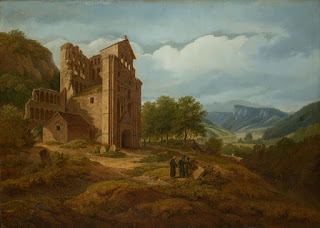"The Oak," observes Mr. Gilpin, "is confessedly the most picturesque tree in itself, and the most accommodating in composition. It refuses no subject, either in natural, or in artificial landscape. It is suited to the grandest, and may with propriety be introduced into the most pastoral. It adds new dignity to the ruined tower, and Gothic arch; it throws its arms with propriety over the mantling pool, and may be happily introduced even in the lowest scene."
From Sylvan sketches; or, A companion to the parks and the shrobbery: with illustrations from the works of the poets (1825) by Elizabeth Kent
This quote about landscape by William Gilpin, influential eighteenth century writer on the Picturesque, is an excuse to mention two books by Elizabeth Kent. This one, Sylvan Sketches, is a guide to trees and it was her follow-up to Flora domestica, or, The portable flower-garden: with directions for the treatment of plants in pots and illustrations from the works of the poets (1823). I've always loved the idea of plant dictionaries based on quotes from poetry and years ago tried to compile one myself, in a vain attempt to lodge in my brain botanical knowledge that would enliven family walks and impress my wife when we visited garden centres. Sadly it failed, as I was always more interested in the poets than the plants. You would be hard pressed to beat Kent's two books though - they are delightful. And what makes them especially interesting is that she was part of the Cockney School, fully conversant with contemporary poets like Keats, Shelley and John Clare, whose work she quotes extensively. Kent was the sister-in-law of Leigh Hunt and worked very closely with him, leading to some contemporary gossip (see Daisy Hay's Young Romantics).
There is of course plenty to say about the oak tree, for example
- She refers to the way poets celebrated an oak planted at Penshurst on the day of Sir Philip Sidney's birth. 'That taller tree which of a nut was set, / At his great birth where all the muses met' (Ben Jonson). Kent says that the Sidney oak 'has since been felled, it is said by mistake : would it be impossible to make a similar mistake with regard to the mistaker?' In fact the oak was older than Sidney and was still going strong when Kent was writing her book. Thomas Packenham included it in his enjoyable survey Meetings with Remarkable Trees (1996), but it died twenty years later. Also on the subject of Sidney and trees, see Rebecca Solnit's negative take which I discussed in a post back in 2011.
- Another thing I once discussed on this blog, was the references to trees, including oaks, in Virgil's Eclogues. Elizabeth Kent quotes his other poems, The Aeneid and The Georgics, in Sylvan sketches. 'Stretching his brawny arms, and leafy hands; / His shade protects the plains, his head the hills commands' (John Dryden's translation).
- She also includes some lovely lines from 'The Floure and the Leafe', then thought to be by Chaucer: 'And to a pleasant grove I gan passe, Long er the bright sunne uprisen was : / In which were okes great, streight as a line, / Under the which the grasse so freshe of hew, / Was newly sprong, and an eight foot or nine / Every tree well fro his fellow grew, / With branches brode, laden with leves new, / That sprongen out agen the sunne-shene, / Some very red, and some a glad light green.
You can read the text of Sylvan Sketches (an 1831 edition) on the Internet Archive).
































